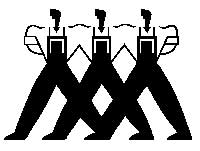What is Woodworm
The most frequent insect pest in wood in buildings in the UK is the common furniture beetle, Anobium punctatum, better known as woodworm.
It has a 5 year life cycle, maximum. We need to look at wood preservatives and their performance - wood treatment is always aimed at breaking the egg laying cycle - so what is that cycle and how does it influence insecticide treatment?
Common furniture beetle starts life as an egg; these are laid on a suitable timber surfaces - but some of these surfaces are cracks and crevices, end grain and, very importantly, down the old emergence holes in pupal chambers and tunnels. The larvae hatch, bore into the sap wood when they remain causing the damage; the larvae are the feeding and growing stages and are by far the longest stage of the insect's life cycle.
At some stage the larva moves close to the surface and constructs a pupal chamber in which it pupates. Between May and August the adult emerges from its pupal skin and chews its way out leaving the familiar 'woodworm holes'. When they cut their way out they do not feed! When emerged they mate and lay eggs, frequently rapidly and very often down the old emergence holes in the pupal chambers and tunnels, i.e.. well below the surface. Indeed, both mating and egg laying can take place within the emergence hole itself.
Spray applied preservatives
The spray applied timber preservative can contain a contact insecticide such as Permethrin or Cypermethrin. Basically all the insect has to do is to come into contact with this material - the insect doesn't have to ingest it; if it did it would also kill it. So one could theoretically argue that contact insecticide has both stomach and contact action. Using an alternative Insecticide, like a Boron based product, only kills the 'grub' or lava when it eats wood. It acts as a stomach 'poison' by affecting the enzymes in the gut. The advantage of this type of treatment is that it does NOT kill flies or spiders - only wood borers - therefore leaving them for the Bats. Boron based products are also superior because that have no vapour - so the active part - the Borate - never leaves the timber, giving permanent protection.
When the wood is sprayed with the preservative it penetrates the surface, probably between 2-6 mm, to leave a protective 'envelope' of insecticide. Any stages initially deluged by the fluid in the 'envelope' will be killed. Those remaining beneath the treatment will survive and continue activity. Clearly these stages will have to come into contact with the insecticidal 'envelope' at some stage for it to be effective. This occurs, at least theoretically, when (a) adults emerge, and (b) larvae hatch from surface laid eggs.
The adults: Adults should be killed as they try to cut their way out of the wood when they cross the 'envelope' containing the contact insecticide; remember they do not feed and must come into contact with the insecticide to have an effect. Therefore the contact acting insecticide should not let them through the treated envelope (non contact insecticides will have no effect on this stage). Indeed, both Permethrin and Cypermethrin like most pyrethroid derived insecticides, are fast acting. Since it does take time to cut emergence tunnels clearly one would expect these beetles to be affected quite rapidly. If under such circumstances, however, they can completely emerge successfully then they haven't been affected by the treatment: they are then free to mate and lay eggs.
Egg larvae
It is well documented that common furniture beetle mates and lays eggs down old tunnels, often well below the surface. Rarely, this can cause hatching beneath the applied treatment, be it a contact insecticide or non contact type insecticide, if the treatment was inadequately applied (two good coats to refusal). As such this will lead to successful hatching and larval survival. Hence the infestation continues, and the treatment must therefore be deemed to have failed.
Books - guides to insects, rots, moulds and damp
Identifying Wood Boring Insects, Rots and Moulds: full colour: BRE - £55.00
Identifying Dampness in Buildings: Coleman - Reprint - £9.99
Boron History | Boron Treatment Range | Woodworm Shop
References | Privacy Policy | Returns Policy | Technical & Safety | Contact | Links | Testimonials

Property Repair Systems
T: 01626 872886
E: help@propertyrepairsystems.co.uk
Site written by: David Moore
David Moore, B.A. (Hons.), C.T.I.S., C.R.D.S. Technical Author
Google+
